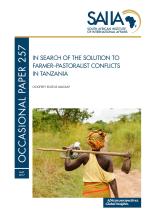Land Library
Welcome to the Land Portal Library. Explore our vast collection of open-access resources (over 74,000) including reports, journal articles, research papers, peer-reviewed publications, legal documents, videos and much more.
/ library resources
Showing items 1 through 8 of 8.Local commons are underutilized in resource management models, thus limiting the effectiveness of the commons concept.
Rangelands throughout sub-Saharan Africa are currently undergoing two major pressures: climate change (through altered rainfall and seasonality patterns) and habitat fragmentation (brought by land use change driven by land demand for agriculture and conservation).
This paper addresses pastoral resilience by drawing out the coping strategies and mechanisms utilized by the Maasai Pastoralists through a food system approach, based on the study findings of an anthropological study of pastoralism as a food system in Laikipia County, Rift Valley, Kenya.
Land-use conflict is not a new phenomenon for pastoralists and farmers in Tanzania with murders, the killing of livestock and the loss of property as a consequence of this conflict featuring in the news for many years n
In the year 2014, the PP has recorded great achievements in terms of revised outcomes. Some unique and strategic approaches employed by the PP are partly the reason for the achievements.
In a modeling study we examine vulnerability of income from mobile (transhumant) pastoralism and sedentary pastoralism to reduced mean annual precipitation (MAP) and droughts. The study is based on empirical data of a 3410 km2 research region in southern, semi-arid Morocco.
Tanzania Natural Resource Forum in partnership with Care international implements a five years pastoralist programme (2012-2016) through registered Tanzanian Civil society Organizations (CSOs) and/or Community Based Organizations (CBOs) that work to improve the capacity of communities to overcome
This study examines the effects of different grazing systems in two neighboring regions with similar biotic and abiotic factors, Nalan Soum in Mongolia and Naren Soum in Inner Mongolia, China.







